Nearly a century ago, Louis Vuitton began its relationship with the arts. Gaston Louis Vuitton, the founder’s grandson, began commissioning artists to create works for the store’s windows. Since then, the house has elaborated on its involvement with the art world, rewriting the meaning of collaboration between the world of luxury and the world of art. Since 1988, Louis Vuitton has produced textiles with artists like Sol LeWitt and James Rosenquist, and in 1996 the maison re-created its monogram design with seven artists: Azzedine Alaïa, Romeo Gigli, Helmut Lang, Isaac Mizrahi, Sybilla, and Vivienne Westwood. Now the brand is celebrating another debut, with fresh artistic visions for its “ArtyCapucines” collection.
First launched in 2013, the line was named after rue des Capucines—the street on which Louis Vuitton first opened in 1854 in Paris. In recent years, the bag has garnered attention for its contemporary shape and style, and, coincidentally, an ability to serve as a blank canvas for artists. Available on June 25 in a limited, numbered edition of 300 bags, the collection was dreamed up by six of today’s top contemporary artists: Sam Falls, Urs Fischer, Nicholas Hlobo, Alex Israel, Tschabalala Self, and Jonas Wood.
Jonas Wood
Jonas Wood’s “ArtyCapucines” bag was originally based on one of his “Landscape Pot” paintings. These celebrated works, created by a painted merging of pots and tropical plants, were transformed for Louis Vuitton. “I paint the things I like, that I am interested in or that I want to investigate. Basketball, tennis, plants, pots. My wife is a ceramist so I paint the vessels she makes as still-life objects, too,” explained the artist.
The shapes and motifs, transferred onto the bag’s calfskin leather using high-resolution printing, first appear in black and white. At closer glance, the creations show their true selves—created in 13 different shades. Further embroidered with over 200,000 stitches that outline the patterns, the pattern is a rich texture full of dimension and depth.
“I really wanted to put some texture, pattern, and color onto the bag. I used sections from three different paintings of mine for the bag’s surface. We developed the outer shell using stained leather that was then sewn into the bag; it was cool the way that we were able to re-create all the details of the painted patterns using totally different materials,” he said.
Additionally, the rings that attach the handle to the bag are treated with a matte finish lacquer, a matte pink LV logo on the front side matches the bag’s lining, and a burst of color adorns the bag with a 3-D printed sunglass-wearing giraffe charm.
“When I was shown the different techniques and materials that we could use to re-create my paintings, one of the things that stood out was the way we could effectively draw a line by using a kind of bundled thread created by the sewing machine. I really like that the thread sits on top of the surface of the bag, it heightens the contrasts of the two colors,” said Wood. “I wanted to make a desirable object for sure. I mean, I don’t use bags, but I would wear it.”
Sam Falls
Sam Falls began this project in Northern California as a large original artwork made especially for the “ArtyCapucines” collection. On a trip to the Louis Vuitton family home, just outside of Paris in Asnières, Falls gathered various flowers and leaves, which he later applied his trademark pigmentation technique to for the collection.
“The first part of the process to think about was the scale, because the work I usually do, using the outdoors, becomes not only life size, but often nature size, incorporating trees and fields and plants that are much bigger than a handbag. That’s ultimately why I worked with small-scale wild flowers and different plants up in northern California. I realized that the best way to approach it was to just do what I do—make an artwork—and then later have that translated onto the bag,” said Falls.
Over 150 high-definition print tests were used to transfer the artwork onto the bag, complete with “drops” of pigment that replicated raindrops, reinterpreted with jacquard weave, hand embroidery over the print, and careful application of mother-of-pearl detailing on the logo and handle rings.
“We started by replicating some of the plants using embroidery, and then developed that process to become part of the surface of the bag. That would create more dimensionality than just the flat surface of the plants on the linen. We then developed another layer of embroidery on top, which gave more perspective, like photography where you have the depth of field, that worked well with the embroidery on top of the painted image,” he said.
Ultimately, for the artist, “My primary objective with this project was to make people happy.”
Urs Fischer
“I’m not somebody who is usually comfortable taking on commissioned work, but occasionally I stumble across something that I am happy to do and this was the case with the Capucines bag,” said Urs Fischer.
Fischer created an entirely new work for this bag, adding a surrealist touch to the collection. Specially for the project, the artist created six hanging sculptures that leave the Taurillon leather bag as the blank canvas it started as.
“Six elements that I wanted to hang from the bag. They are just beautiful things from nature: fruits, vegetables, an egg, as opposed to man- made things like sneakers or car tires,” he said.
The artist focused on the hyper-realistic 3-D charms that dangle from gold-plated brass chains—a banana, a strawberry, an apple, a mushroom, an egg, and a carrot. Made in a mold and featuring hand-painted detailing, the silicone pieces are based on real fruits and vegetables that symbolize nature and daily life.
“Artworks don’t really exist in the real world, if that makes sense. They tend to be like complicated children who still live with their parents and don’t want to move out. They don’t go out as much as they should to challenge themselves,” said Fischer. “For me, with this bag you take a certain mindset but you bring it out into a far broader world by having people taking it out while they go for a walk.”
Tschabalala Self
Tschabalala Self’s contribution was crafted with found fabrics and materials for entirely new meaning. Carefully arranged layering was the basis of her work, first achieved by deconstructing the Louis Vuitton Monogram pattern.
“My first idea was to produce a figurative work for the bag but then I started thinking more critically about what the most exciting aspect of my paintings is. It’s not so much the figures as it is the deconstruction of the form, and the idea of then building that back up again,” said the artist. “So, my idea was to apply that same thinking to the Louis Vuitton logo: breaking it down into different elements, breaking those elements into smaller elements, and then re-using the logo fragments as building blocks for a new form.”
These elements were further broken down and rebuilt into new forms with the use of 19 different types of leather—including lizard on the flap and bottom of the bag. Some of the material, as well, was upcycled from the house’s atelier.
“It was particularly exciting to experience the access that Louis Vuitton has to so many different exotic materials, leathers, and colors. I was amazed at how accurately the bag could be rendered to look exactly like my proposal,” she said.
Unrestrained stitching, playfully irregular patchwork, and deliberately hanging threads added layers of Self’s work, with over 200 different exterior elements lending way to an entirely unique artistic object full of powerful expression.
“I made the bag keeping in mind something that I would want to wear myself. I thought the person who might buy this bag would maybe have a more overall conservative style but might want some objects that are super gaudy or poppy,” said Self.
Alex Israel
Alex Israel’s bold creation centers on Los Angeles life. The artist’s signature bright, high-gloss approach is transplanted onto this new piece.
“Los Angeles is at the heart of my work. It’s a city driven by innovation and imagination, and it’s incredible how much creative output constantly pours out of the landscape. It’s a place where people come to reinvent themselves and where just about anything is possible. Even though the American dream doesn’t come true for everyone, in Los Angeles it exists as a real possibility, and that’s a powerful thing. That feeling of possibility, of being surrounded by creativity and self-invention, that profoundly inspires me and my work,” said the L.A.-based artist.
The Louis Vuitton atelier worked tirelessly to find the perfect leather for Israel’s high-definition digital printing, to keep its lustrous finish. This finish—a cheeky nod to the sunscreen and wetsuits worn in California—also brought his iconic wave motif to life. Above the bag’s body, two removable surfboard fins rise high in a semitransparent acrylic glass.
“I decided to reimagine the surface of the bag as one of my ‘Wave’ paintings. We’re a beach culture here in Southern California, and waves dictate the rhythm and pace of L.A. life. My Wave was born out of an animated sequence in my film SPF-18,” he said.
Adding to the allure is functionality—one board is equipped with a metal comb attached to it, and the other features a built-in mirror. And if you explore a bit more, you’ll come across another special detail: Israel’s enigmatic profile portrait is transformed into a metal zipper pull, fastened to the interior pocket.
“The most exciting thing for me about doing a project like this is that you do get to put things in the world in a different way, and potentially reach a different audience for your work. I love the art world and I love making exhibitions, but I also love making products, videos, books, and sunglasses. There are so many audiences out there, and so many people who don’t make it to museums and galleries—and I want
those people to also be able to experience my work in the places they go, and through the platforms they might access,” said Israel.
Nicholas Hlobo
Nicholas Hlobo’s vibrant interpretation is an elegant play on materials, textures, and patterns.
“The work is autobiographical: my rapport with South Africa, my ethnicity, and my gender identity. I was born in Cape Town to parents from what was called the Homelands, part of the apartheid reserves. It was only classified as South Africa when we had the first elections in 1994. So, having been brought up in a foreign land in the countryside, and then later moving to Johannesburg, has brought richness into my tapestry as a human being in South Africa,” explained Hlobo. “Today, my studio is in Johannesburg, which is my favorite place in the world. The city has no apparent natural beauty—no mountains or rivers— but there is beauty hidden beneath the surface.”
Inspired by the flower in Louis Vuitton’s Monogram pattern, the artist stitched patches of blue leather directly onto the bag’s black exterior. Seemingly grown from behind the surface, the detailing took the house’s craftspeople over 40 hours of atelier work to create.
“I wanted to mirror the ways I use different materials in my work. I stitch on my paintings and drawings, and my sculptures are created by layering found materials such as leather, tire tubes, and copper pipes. I started by looking at the Louis Vuitton motifs, in particular the flower. I felt that I could interpret it as something growing from the bag, literally emerging from it,” he said.
A stunningly hybrid item, the bag was produced to retain the original feeling of a craft object. Each imperfection, completely transformed into another facet of the bag’s nature, embodies the exact novelty that makes a craft piece what it’s cherished for.
“I am more curious about the ugliness that lies beneath the surface yet informs the beauty. Physical human beauty is not necessarily defined by surface skin; it’s determined by what’s happening underneath—how the bones push through the skin, muscles, and ligaments—which is not beautiful if we were to look at it. This collaboration was a wonderful opportunity to ‘cut’ through the Louis Vuitton bag and make beautiful things grow out of it,” said Hlobo.












